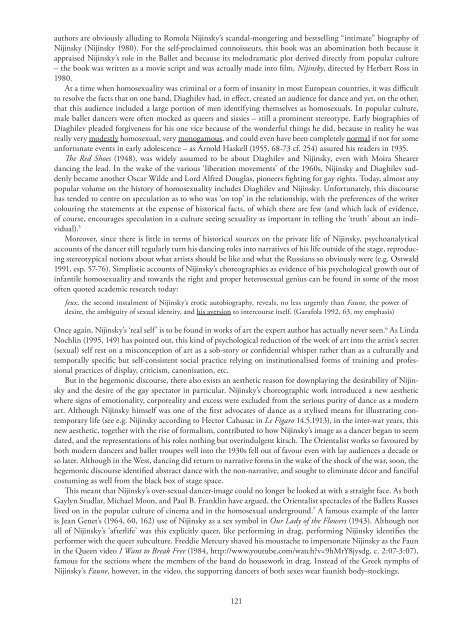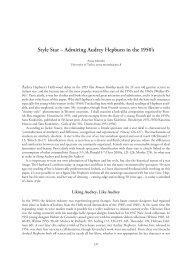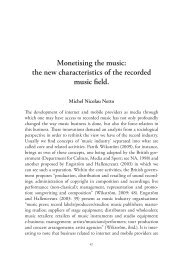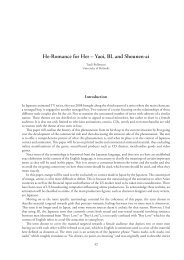Fans, Fawns and Fauns: Ballet Stardom, Dancing Genius and ... - IIPC
Fans, Fawns and Fauns: Ballet Stardom, Dancing Genius and ... - IIPC
Fans, Fawns and Fauns: Ballet Stardom, Dancing Genius and ... - IIPC
You also want an ePaper? Increase the reach of your titles
YUMPU automatically turns print PDFs into web optimized ePapers that Google loves.
authors are obviously alluding to Romola Nijinsky’s sc<strong>and</strong>al-mongering <strong>and</strong> bestselling “intimate” biography of<br />
Nijinsky (Nijinsky 1980). For the self-proclaimed connoisseurs, this book was an abomination both because it<br />
appraised Nijinsky’s role in the <strong>Ballet</strong> <strong>and</strong> because its melodramatic plot derived directly from popular culture<br />
– the book was written as a movie script <strong>and</strong> was actually made into film, Nijinsky, directed by Herbert Ross in<br />
1980.<br />
At a time when homosexuality was criminal or a form of insanity in most European countries, it was difficult<br />
to resolve the facts that on one h<strong>and</strong>, Diaghilev had, in effect, created an audience for dance <strong>and</strong> yet, on the other,<br />
that this audience included a large portion of men identifying themselves as homosexuals. In popular culture,<br />
male ballet dancers were often mocked as queers <strong>and</strong> sissies – still a prominent stereotype. Early biographies of<br />
Diaghilev pleaded forgiveness for his one vice because of the wonderful things he did, because in reality he was<br />
really very modestly homosexual, very monogamous, <strong>and</strong> could even have been completely normal if not for some<br />
unfortunate events in early adolescence – as Arnold Haskell (1955, 68-73 cf. 254) assured his readers in 1935.<br />
The Red Shoes (1948), was widely assumed to be about Diaghilev <strong>and</strong> Nijinsky, even with Moira Shearer<br />
dancing the lead. In the wake of the various ‘liberation movements’ of the 1960s, Nijinsky <strong>and</strong> Diaghilev suddenly<br />
became another Oscar Wilde <strong>and</strong> Lord Alfred Douglas, pioneers fighting for gay rights. Today, almost any<br />
popular volume on the history of homosexuality includes Diaghilev <strong>and</strong> Nijinsky. Unfortunately, this discourse<br />
has tended to centre on speculation as to who was ‘on top’ in the relationship, with the preferences of the writer<br />
colouring the statements at the expense of historical facts, of which there are few (<strong>and</strong> which lack of evidence,<br />
of course, encourages speculation in a culture seeing sexuality as important in telling the ‘truth’ about an individual).<br />
5<br />
Moreover, since there is little in terms of historical sources on the private life of Nijinsky, psychoanalytical<br />
accounts of the dancer still regularly turn his dancing roles into narratives of his life outside of the stage, reproducing<br />
stereotypical notions about what artists should be like <strong>and</strong> what the Russians so obviously were (e.g. Ostwald<br />
1991, esp. 57-76). Simplistic accounts of Nijinsky’s choreographies as evidence of his psychological growth out of<br />
infantile homosexuality <strong>and</strong> towards the right <strong>and</strong> proper heterosexual genius can be found in some of the most<br />
often quoted academic research today:<br />
Jeux, the second instalment of Nijinsky’s erotic autobiography, reveals, no less urgently than Faune, the power of<br />
desire, the ambiguity of sexual identity, <strong>and</strong> his aversion to intercourse itself. (Garafola 1992, 63, my emphasis)<br />
Once again, Nijinsky’s ‘real self’ is to be found in works of art the expert author has actually never seen. 6 As Linda<br />
Nochlin (1995, 149) has pointed out, this kind of psychological reduction of the work of art into the artist’s secret<br />
(sexual) self rest on a misconception of art as a sob-story or confidential whisper rather than as a culturally <strong>and</strong><br />
temporally specific but self-consistent social practice relying on institutionalised forms of training <strong>and</strong> professional<br />
practices of display, criticism, canonisation, etc.<br />
But in the hegemonic discourse, there also exists an aesthetic reason for downplaying the desirability of Nijinsky<br />
<strong>and</strong> the desire of the gay spectator in particular. Nijinsky’s choreographic work introduced a new aesthetic<br />
where signs of emotionality, corporeality <strong>and</strong> excess were excluded from the serious purity of dance as a modern<br />
art. Although Nijinsky himself was one of the first advocates of dance as a stylised means for illustrating contemporary<br />
life (see e.g. Nijinsky according to Hector Cahusac in Le Figaro 14.5.1913), in the inter-war years, this<br />
new aesthetic, together with the rise of formalism, contributed to how Nijinsky’s image as a dancer began to seem<br />
dated, <strong>and</strong> the representations of his roles nothing but overindulgent kitsch. The Orientalist works so favoured by<br />
both modern dancers <strong>and</strong> ballet troupes well into the 1930s fell out of favour even with lay audiences a decade or<br />
so later. Although in the West, dancing did return to narrative forms in the wake of the shock of the war, soon, the<br />
hegemonic discourse identified abstract dance with the non-narrative, <strong>and</strong> sought to eliminate décor <strong>and</strong> fanciful<br />
costuming as well from the black box of stage space.<br />
This meant that Nijinsky’s over-sexual dancer-image could no longer be looked at with a straight face. As both<br />
Gaylyn Studlar, Michael Moon, <strong>and</strong> Paul B. Franklin have argued, the Orientalist spectacles of the <strong>Ballet</strong>s Russes<br />
lived on in the popular culture of cinema <strong>and</strong> in the homosexual underground. 7 A famous example of the latter<br />
is Jean Genet’s (1964, 60, 162) use of Nijinsky as a sex symbol in Our Lady of the Flowers (1943). Although not<br />
all of Nijinsky’s ‘afterlife’ was this explicitly queer, like performing in drag, performing Nijinsky identifies the<br />
performer with the queer subculture. Freddie Mercury shaved his moustache to impersonate Nijinsky as the Faun<br />
in the Queen video I Want to Break Free (1984, http://www.youtube.com/watch?v=9hMrY8jysdg, c. 2:07-3:07),<br />
famous for the sections where the members of the b<strong>and</strong> do housework in drag. Instead of the Greek nymphs of<br />
Nijinsky’s Faune, however, in the video, the supporting dancers of both sexes wear faunish body-stockings.<br />
121







